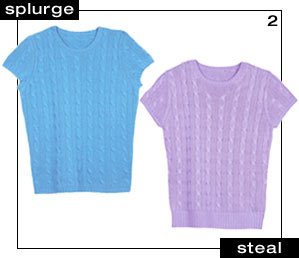I'm a huge fan of Marie Claire's Splurge v.s Steal column... A "leather bag snob" I opted for the real Coach and to this day it's my favorite bag... a mere fan of cashmere I saved over $200...
One of my longest and most thoroughly research papers in law school was a piece on copyright protection for fashion designers in the United States. I went into the paper disgusted at our country's lack of protection -- but in the end concluded (much to my chagrin) that not only was there no good way to protect designers and their designs, but that doing so would stifle creativity. As I'm sure you know, last week the New York Times ran a story about the Council of Fashion Designers of America's latest attempt (there have been tries by other organizations in the past) to pass legislation which would in effect protect a design for three years from its date of publication. This is big news for fashion designers big and small... and consumers should keep their eyes on it as well.
The problem I see with protecting fashion designs is three fold:
(1) Protection, it would seem, would be most beneficial to those with the resources to protect. Imagine some small independent designer battling it out with a mega company like Gucci over the rights to a certain dress style. The fees associated with copyright protection have even the simplest application costing well over $100, and court battles over "who made it first" can cost thousands! It seems to me this would have a negative effect on creativity at both ends. Little fashion designers may find themselves reluctant to publish their designs and bigger companies that can afford protection would have exclusive rights to a style for three years.
(2) I understand the disdain for true knock-offs... When imitators pose as the real thing, using the company's name, logo, and likeness they should be punished as that's blatant copyright infringement. But fashion look-alikes, to me, are another story. Sites like Frugal-Fashionista, for example, take high-priced celebrity fashions and show you how you can achieve a similar look for hundreds less. H&M, Guess, and even stores like Old Navy have been known to take super-high priced styles and tone them down (both in craftsmanship and price) for the average shopper. My my main question, which is also my main point, is: are luxury brands really loosing money or brand recognition when their items are imitated by lower-cost brands? In other words, I may like what Chloe is offering this spring, but under no circumstances can I afford anything from that line. I can however, afford the cute [insert name] look-alike. In know way is Chloe loosing a sale from me, and in no way would a real Chloe brand snob ever mistake my cheaper brand for the real thing. The same goes for all of these high priced brands... as much as they may like to think the cheaper brands are taking away from sales or are tarnishing brand image, I personally find the whole thing hard to believe.
(3) Lastly, love it or hate the the lack of design protection has had some interesting effects on the industry itself. The excessive branding you see everywhere... C's and G's and LV's... is in part due to the lack of protection designers have with respect to their actual designs. This may be a bad thing if you, like me, are sick of seeing these women... walking brands or branded as I like to call them, dressed head to toe in splashy logos... On the other hand, graphic designers, typographists and even graffiti artists have been able to get their feet wet in the fashion game as a result.
In the end I don't think the design protection legislation will pass... but it is something to keep you eye on and think about. For smaller designers, I urge you to be aware of how movements like this might affect your work. If you're passionate about it one way or another, you should get involved! Consumers too... should be aware. What's good for big fashion houses may not be good for the average customer.
Anyway, this it totally my opinion on the matter, but I hope it at least sparked some interest on your part. For more info on copyright protection check here. The CFDA's site is here. And unfortunately they NY Times Article is now a pay-piece... but you can read more about it here.

